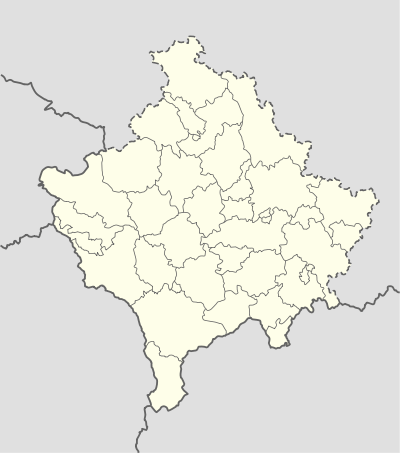Lupçi i epërm
| Gornje Ljupče/Lupçi i epërm | |
|---|---|
| Village | |
 Gornje Ljupče/Lupçi i epërm | |
| Coordinates: 42°51′15″N 21°5′40″E / 42.85417°N 21.09444°ECoordinates: 42°51′15″N 21°5′40″E / 42.85417°N 21.09444°E | |
| Country | Kosovo |
| District | District of Pristina |
| Municipality | Podujevo |
| Elevation | 751 m (2,467 ft) |
| Time zone | Central European Time (UTC+1) |
| • Summer (DST) | CEST (UTC+2) |
| Postal code | 11050 |
Lupçi i epërm (in Albanian) or Gornje Ljupče or (in Serbian; Горње Љупче) is a village located in the municipality of Podujevo, District of Pristina, Kosovo.
Geography
Lupçi i epërm is located on the gorge of Kačandol river (major tributary of the river Lab). Village has a close geographical position toward four municipal centres in north-eastern Kosovo: Podujevo (10 km / 6 mi. ENE), Vučitrn (11 km / 7 mi. WSW), Kosovska Mitrovica (19 km / 12 mi. W), Pristina (21 km / 13 mi. SSE).[1]
Lupçi i epërm borders with three other villages, Popovo (Kështjellas) to the north, Majac to the south, and Zogaj-Zagorje (Municipality of Vučitrn) to the south-west. Main neighborhoods of the village itself are: Dushi, Menxhiqi and Grabovci.
NDSH Insurgency 1945 - 1947
After the WWII, the area was the sene of fighting between the Albanian National Democratic Army, military wing of Albanian National Democratic Movement (NDSH) and special units of the Yugoslav Army, the fighting lasted until February 1, 1947. In the final battle, thirteen nationalist guerrillas led by Shaban Bunjaku fought to the death. Yugoslav soldiers, continued with atrocities among local population and had executed five people from the village,[2] on charges that they had provided aid and shelter to nationalist combatants.[3]
On June 19, 2005, was discovered a mass grave with remains of warriors, in which besides thirteen fighters killed in the area, also were found the remains of other fighters, among them Ukshin Kovaçica.
Kosovo War
During the Kosovo War, the town was under firm control of local Territorial Defence unit under coordination of Kosovo Liberation Army.
During the time of conflict number of civilians was seeking shelter in the area. It was reported that UNHCR arranged delivery of food and blankets for the IDPs scattered at Gornje Ljupče.[4] Because of its central position in the gorge of Kaçanoll river area, which was under complete control of KLA, it was relatively a safe area with the distance of around 7 km (except during May 1999) from the Donje Ljupče frontline between KLA and Serbian forces. On `15 1999, during the air campaign of NATO on targets in FR Yugoslavia, NATO airplanes landed four missiles against Yugoslav forces surrounding the village.[5]
According to the Serbian sources, area which included also nearby villages, was scene of around three thousand local non-uniformed armed force.[6]
References
- ↑ http://www.places-in-the-world.com/790427-xk-distances-from-gornje-ljupce-to-the-largest-places-in-kosovo.html
- ↑ Based on the testimony of the witness Idriz Mengjiqi (1920), civilians executed on February 1, 1947 are Rexhep Tahir Dushi, Bajram Jonuz Menxhiqi, Bajrush Menxhiqi, Deli Grabovci, Rrahim Retkoceri
- ↑ http://www.zemrashqiptare.net/article/Speciale/12820/1/print/
- ↑ "Kosovo: humanitarian situation deteriorating rapidly". January 29, 1999. UNHCR.
- ↑ Glas Javnosti (May 15, 1999). Glas Javnosti http://arhiva.glas-javnosti.rs/arhiva/1999/05/13/en-latest-news-0512.html. Missing or empty
|title=(help) - ↑ "International Criminal Tribunal for the former Yugoslavia".